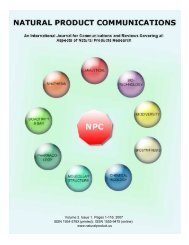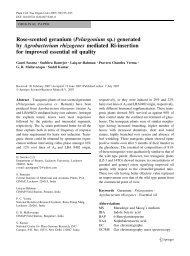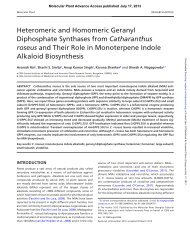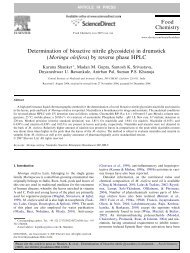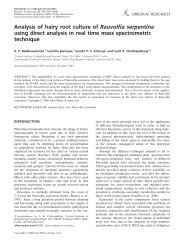Birendra Kumar*, SK Verma, G Ram,HP Singh. 2012 ... - CIMAP Staff
Birendra Kumar*, SK Verma, G Ram,HP Singh. 2012 ... - CIMAP Staff
Birendra Kumar*, SK Verma, G Ram,HP Singh. 2012 ... - CIMAP Staff
- No tags were found...
You also want an ePaper? Increase the reach of your titles
YUMPU automatically turns print PDFs into web optimized ePapers that Google loves.
Temperature Relations for Seed Germination and Vigor in Palmarosa 797<br />
Lowest germination percentage was recorded for Vaishnavi (14.0%) at 20 ◦<br />
and 30 ◦ C, followed by Tripta (32.5%), Trishna (37.5%), and PRC-1 (38.3%) at<br />
35 ◦ C (Table 2). The optimum germination in respect to all varieties was<br />
observed at 25 ◦ C and was followed by 20 ◦ C, except variety Vaishnavi;<br />
the latter recorded the lowest germination at 20 ◦ and 30 ◦ C. The discrepancy<br />
in germination behavior of Vaishnavi may be because of its deviated<br />
reproductive behavior and genotype. Decrease in germination at 30 ◦ and<br />
35 ◦ Cfrom25 ◦ C was significant for all the varieties; however, from 30 ◦ to<br />
35 ◦ C neither a significant increase (Trishna and Vaishnavi) nor a decrease<br />
(PRC-1 and Tripta) was observed. Thus, the results indicated that the temperature<br />
of 25 ◦ C was optimum for Palmarosa seed germination and that<br />
an increase in temperature beyond 25 ◦ C would lead to a decrease in<br />
germination.<br />
Downloaded by [<strong>Birendra</strong> Kumar] at 06:15 20 November <strong>2012</strong><br />
SeedlingVigorIndexI&II<br />
The variety and temperature affected both seedling vigor index I and<br />
seedling vigor index II of Palmarosa seeds, and variation attributable to these<br />
two main factors was highly significant. The mean seedling vigor index I and<br />
II of Palmarosa varieties across temperatures varied from 150.7 and 0.0803<br />
(Vaishanvi) to 207.6 and 0.1862 (Tripta), respectively. For all varieties, the<br />
highest values for seedling vigor indices I and II were recorded at 25 ◦ C,<br />
which was the optimum temperature for germination of all the varieties.<br />
However, unlike the variety × temperature interaction for germination, there<br />
was no consistent pattern with regard to lowest seedling vigor at temperatures<br />
higher than or lower than 25 ◦ C. Growers would want to avoid the<br />
conditions that result in the lowest seedling vigor, but as can be seen in<br />
Table 2, this varies with the variety. The optimum seedling vigor index<br />
I for all varieties was observed at 25 ◦ C, followed by 20 ◦ C, except variety<br />
Vaishnavi, which had the lowest germination at 20 ◦ and 30 ◦ C. The differential<br />
response of Vaishnavi relative to seedling vigor index I may be attributed<br />
to its deviated reproductive behavior (self-pollination) and genetic background,<br />
as previously noted. Decrease in seedling vigor index I at 35 ◦ C<br />
(compared to that at 25 ◦ C) was significant for all the varieties. A significant<br />
decrease in seedling vigor index I with a temperature increase from 30 ◦ to<br />
35 ◦ C was recorded in varieties Trishna, Tripta, and PRC-1, but not Vaishnavi<br />
(Table 2). Thus, the results indicated that 25 ◦ C was the optimum temperature<br />
for Palmarosa seedling vigor index I; temperatures beyond 25 ◦ Ccaused<br />
a decrease in seedling vigor index I. For seedling vigor index II, 25 ◦ Calso<br />
was the optimum temperature, followed by 30 ◦ C in varieties Tripta, PRC-1,<br />
and Trishna, but not variety Vaishnavi for which 25 ◦ C followed by 35 ◦ Cwas<br />
optimal. Decrease in seedling vigor index II at 30 ◦ and 35 ◦ C (compared to<br />
25 ◦ C) was significant for all the varieties. A significant decrease in vigor index<br />
II with a temperature increase from 30 ◦ to 35 ◦ C occurred in varieties Tripta




